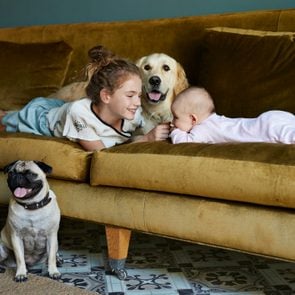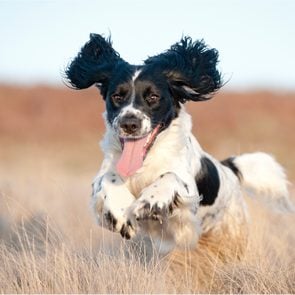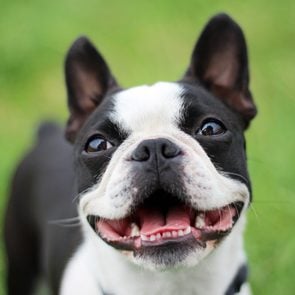15 Popular Dog Breeds with Gorgeous, Curly Hair
Updated: Mar. 08, 2024
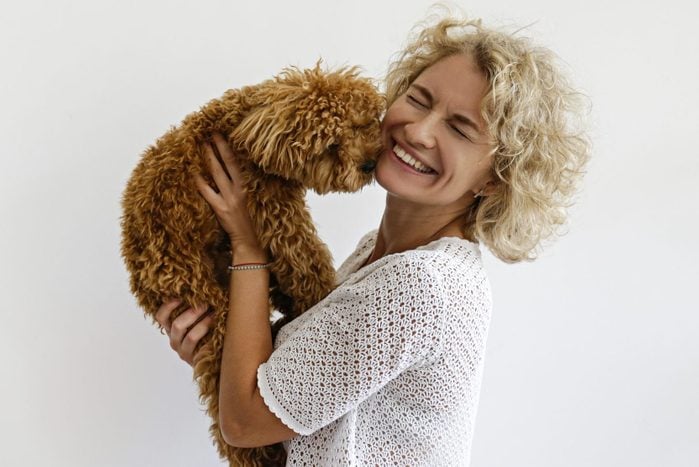
Looking to adopt a new pup? Check out these interesting, adorable, and perfectly coiffed curly-haired dog breeds.
Curly-haired dogs are some of the most distinctive breeds out there like short-legged dogs, dogs that look like a lion, and adorably wrinkly bulldog breeds. And despite a proliferation of poodles and Labradoodles in the world, true curly coats in dogs are not that common. To have curly hair, a puppy must inherit two mutations of the KRT71 gene—inheriting just one will result in wavy, not curly hair. So your curly-haired pup is a rare dog breed, indeed!
Many curly-haired breeds were developed either as water dogs, for helping fishermen or aiding in aquatic rescue, or as herders in cold, wet climates, such as that of the British Isles, according to the American Kennel Club. Those working dogs might not have spent much time at the groomer’s but today, most curly-haired dog breeds require a fair amount of maintenance in order for their coats to remain clean and healthy. Many curly-haired breeds are either non-shedders, hypoallergenic, or both for households where someone suffers from allergies.
Let’s take a look at some popular, quirky, and unusual breeds with lovely, curly locks. And remember, you don’t need to find a purebred pooch—there are plenty of curly-haired pups at local shelters. But if you have a specific breed in mind, be sure to check for breed-specific rescue groups in your area.
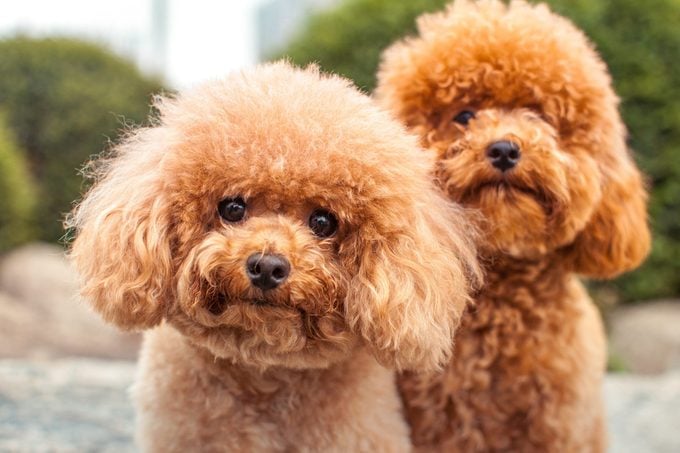
1. Poodle
Whether standard, miniature, or toy, a poodle is going to have curly hair. In any size, they remain one of the most popular dog breeds in the world. Originally bred for retrieving ducks from the water, these curly-coated companions are now loved for their dignified posture and curious expressions. They’re also hypoallergenic and they don’t shed, which makes them great for allergy-sufferers. Young poodles appreciate a lot of exercise and will fetch a stick or ball forever. All sizes of poodle need regular trimming and brushing, or else their fur will tangle and mat.
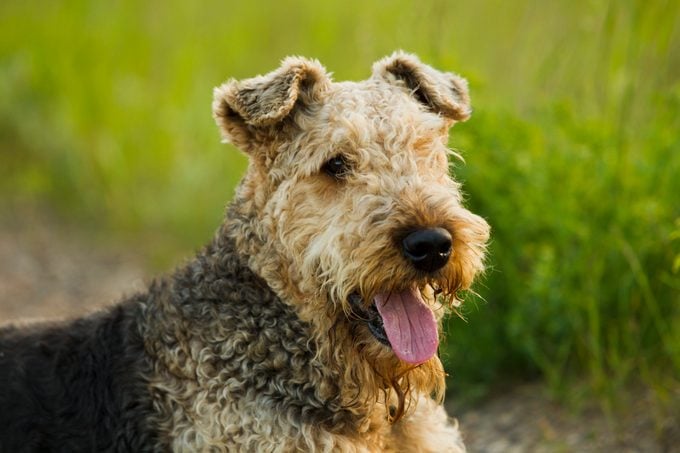
2. Airedale terrier
Originally bred around the factories of Aire, England, and used for duck hunting and rodent control, Airedale Terriers—the largest terriers of the bunch—still retain a strong prey instinct. And while they are sweet and loyal clowns, they can also be stubborn and challenging to train. Their wiry, tightly curled coats need regular brushing, but Airedales generally only need a haircut a few times a year. They’re also low-shedding and compatible with allergy sufferers.
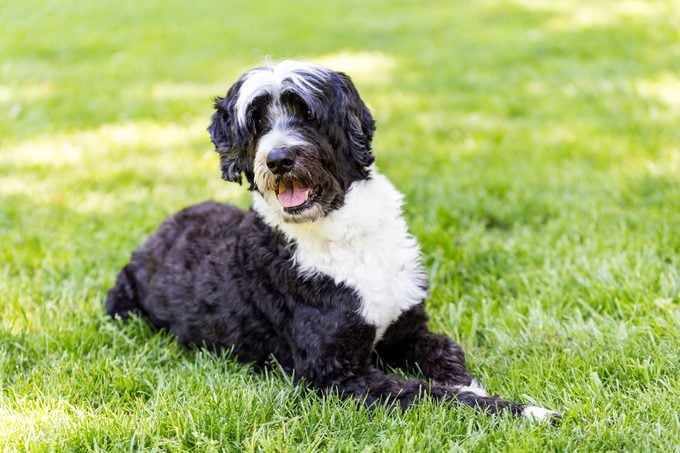
3. Portuguese water dog
Remember Bo, the beloved Obama family dog during their time in the White House? He was chosen for the family because of daughter Malia’s allergies—despite being shedders, curly-haired Portuguese Water Dogs are hypoallergenic. These medium-sized dogs were bred for corralling fish into nets and their thick coats made them impervious to frigid water temperatures. Today, these lovable, easily trainable family dogs need daily brushing and the occasional trim to keep their hair out of their eyes.
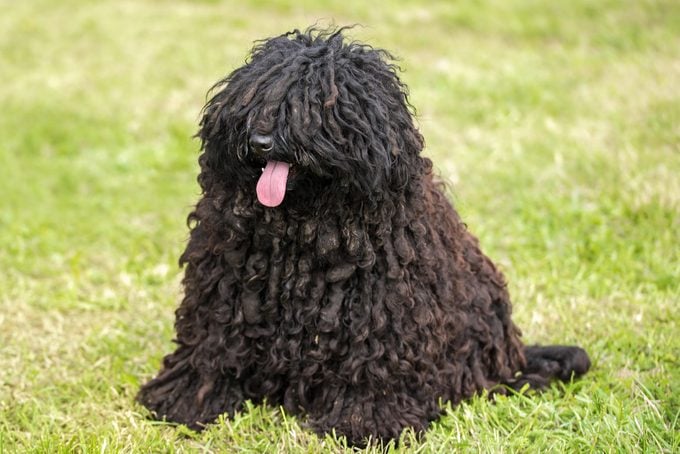
4. Puli
If you’ve ever encountered a Puli dog, he probably made a big impression. The breed’s long, curly hair naturally forms into dreadlock-like curls, giving him the appearance of a four-legged mop. A Puli coat can be left corded since that’s the distinct look for the breed, can be combed out so that he resembles a giant puffball, or trimmed short—though this should only be done by a professional groomer. Originally bred as herding dogs that were impervious to cold weather and icy waters, these affable family dogs are playful and obedient.
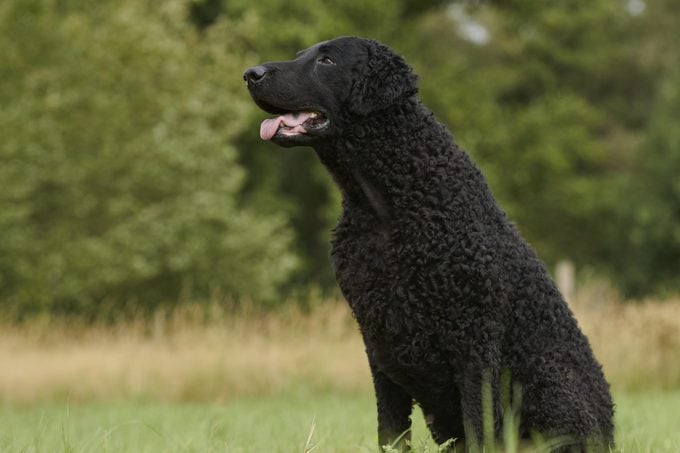
5. Curly-coated retriever
A curly-coated retriever’s coat is simply amazing. These large dogs—prized as hunters for their ability to withstand, water, snow, thorny underbrush, and other hostile conditions—are covered in tight, ringlet curls that rarely need to be trimmed and shouldn’t be brushed. Instead, the occasional pass with a grooming rake is all they need and they’re good to go. Extremely smart and full of energy, these beauties need to be kept busy with regular exercise and other stimulation.

6. Barbet
If you’re a sucker for a cute dog with its own hair accessories, then a Barbet may be the breed for you. With long, shaggy hair in a variety of colors, Barbets are frequently spotted sporting a barrette or hair tie to keep their fur out of their eyes. Although they’re low shedders, these friendly, playful dogs need to be brushed out about once a week so that their thick fur doesn’t mat or tangle. These clever pups love to swim and need to be kept busy and exercised, lest they wreak havoc in your home.
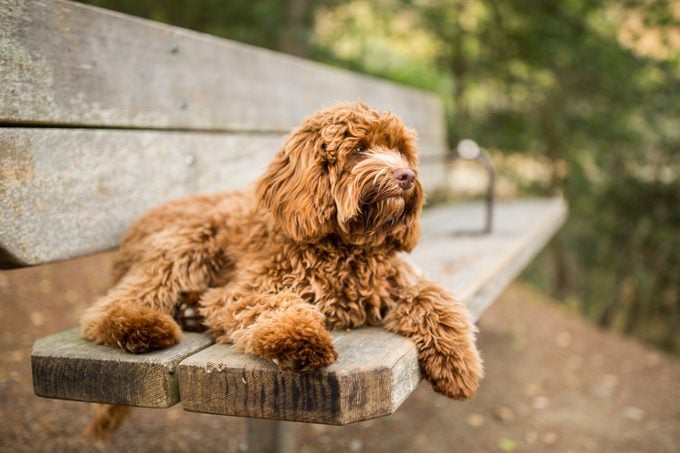
7. Labradoodle
Although not a recognized “official” breed, Labradoodles—a cross between a poodle and a Labrador retriever—are among the most popular “mutts” out there. Whether your doodle has curly, wavy, wiry, or straight hair depends on how much KRT71 gene it inherits from its poodle bloodline. Whatever his coat is like, a Labradoodle doesn’t shed but needs regular brushing. Keep these playful, active dogs occupied and don’t let them get lonely—they are definitely people pups! Don’t miss more wiry haired dogs you will absolutely love.
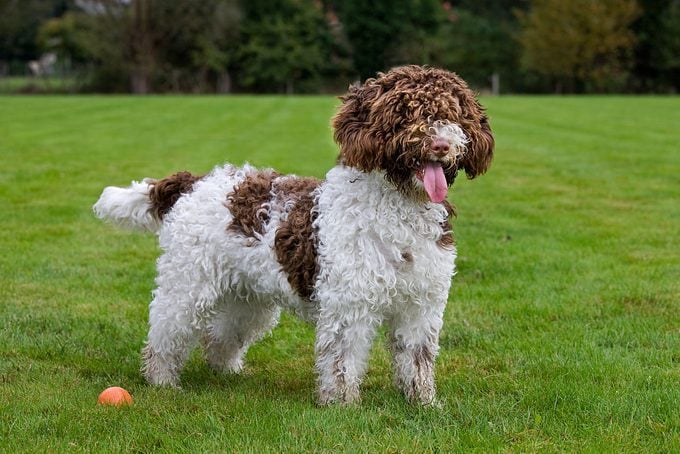
8. Spanish water dog
These smart, agile, yet goofy-looking dogs have long, mop-like coats that, in the hands of the right groomer, can be “corded” similarly to a Puli. Otherwise, Spanish water dogs’ coats can be sheared once a year or regularly trimmed, depending on owner preference. Their coats should not be brushed, but rather left to curl naturally. Because these cuties have a strong herding instinct and like to have a “job” to do, they need a lot of exercise and do well in an active household.
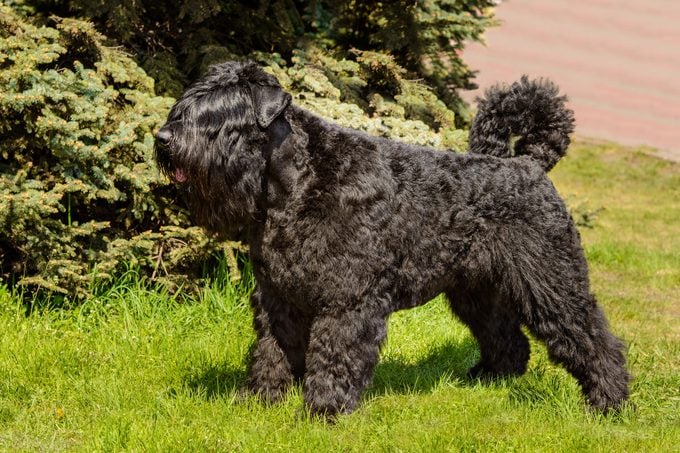
9. Bouvier des Flandres
Life’s a lot easier than it used to be for the average Bouvier des Flandres. Bred as hard-laboring farm dogs, this curly-wavy-haired breed originated in what is now, Flanders, Belgium. The breed was almost wiped out as the result of World War I and II and today is a beloved family dog that’s especially good with children that also makes for a surprisingly good guard dog. These guys need room to romp, so a large, fenced-in yard suits them best. Daily brushing is a must.
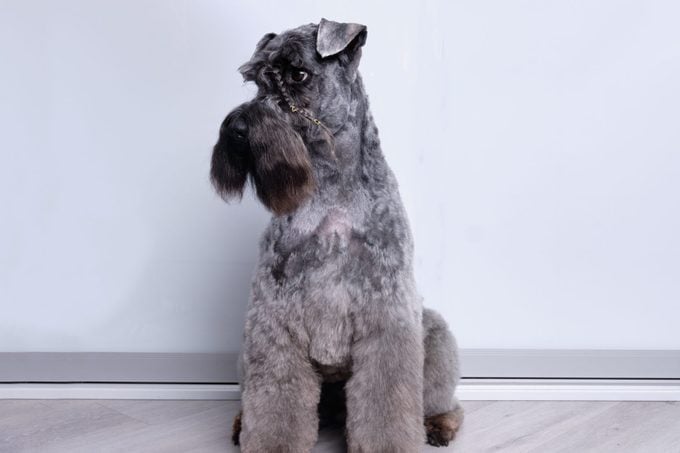
10. Kerry blue terrier
These sturdy, tall-standing dogs are unique for their one-of-a-kind blue-grey coats, which are soft and tightly curled, with no undercoat. First bred as rodent-hunters and later used as herding dogs, distinct-looking Kerry Blues make loyal family pets and do best with some obedience training while they’re young. Their beautiful coats need frequent brushing as well as grooming—either at home or in the hands of a professional—about every six to eight weeks.

11. Pumi
They may be curly-haired cuties, but Pumi dogs (the plural is Pumik) were bred in Hungary as hard-working herding dogs. They still like to be kept busy, either with herding tasks or endless games of fetch. Fortunately, your Pumi’s softly curled coat won’t keep you too busy. These light shedders need brushing a few times a week, then a wet down so their curls can spring back to life. You might want to trim his coat from time to time, especially around the face, but regular trips to the groomer aren’t a necessity with this energetic breed.
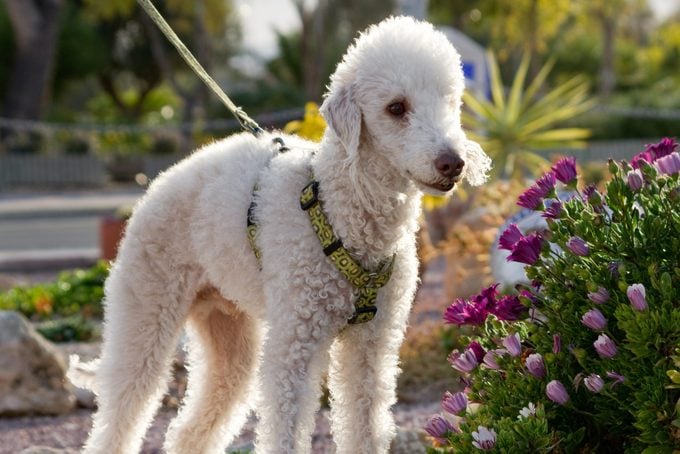
12. Bedlington terrier
Are you ready for a Bedlington Terrier to bounce into your life? This sweet little terrier has a unique, pear-shaped head, a curved back, and a fluffy coat that makes him look as much like a lamb as a pup. Bedlington’s don’t shed, but they do need brushing several times a week to keep their fur from matting. Many owners like to keep them sheared so that their distinct form is more visible. These loyal dogs want nothing more than to romp and play, especially with little kids.
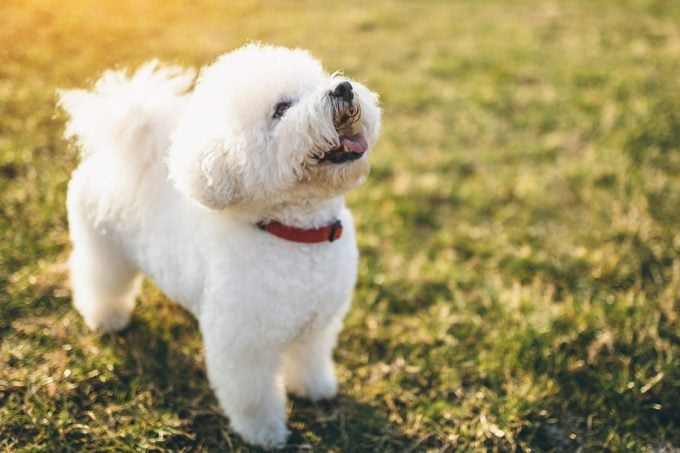
13. Bichon Frise
If you’re partial to dogs that look as cute as stuffed animals—and that are hypoallergenic and don’t shed—then it may be time to welcome a Bichon into your home. With their impossibly adorable faces and fluffy white coats, Bichons are one of the most popular curly dog breeds. They love spending time with their families and are great apartment dogs. But they do need regular trips to the groomers and almost daily brushing, lest that fluffy coat turns into a matted mess.
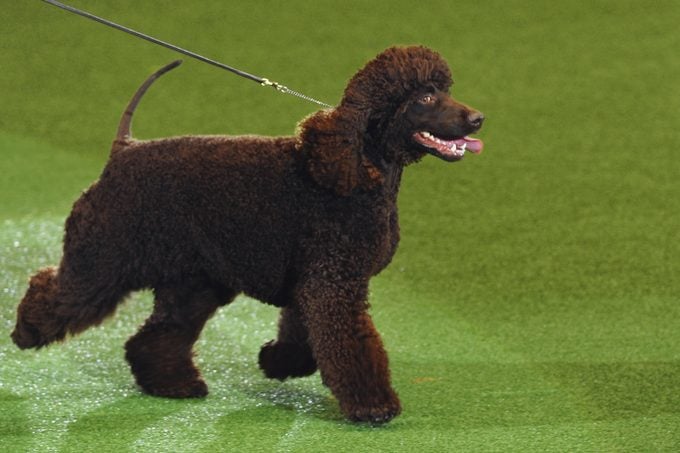
14. Irish water spaniel
With the face of a Cocker Spaniel and the size and coat of a Standard Poodle, the Irish Water Spaniel is a hypoallergenic clown of a dog, with boundless energy and a strong sense of playfulness. Natural swimmers—with webbed feet, no less!—these pups love nothing more than the chance to splash around in a pool or lake. Their coats contain oil that makes them water repellent but that also holds dirt, so they need frequent brushing, as well as occasional home trimming or trips to the groomer.

15. Komondor
If you’re an experienced dog owner with a soft spot for rare dog breeds with strong personalities—and really unique coats, then a Komondor might be for you. Bred to protect sheep from predators, these cord-coated dogs may keep a watchful eye over you and yours all day and may be wary of strangers. These big, energetic furballs need regular exercise and plenty of room to run. Grooming is a chore, too. Their coats need to be corded and when washed, need to be thoroughly dried, as a wet Komondor is a stinky Komondor.

